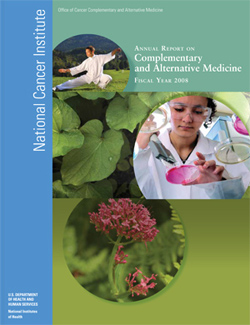Meetings and Events
Spring 2013
Vol. 8, Issue 1
Winter 2013
Vol. 7, Issue 2
Spring 2012
Vol. 7, Issue 1
Spring 2011
Vol. 6, Issue 1
Fall 2011
Vol. 6, Issue 2
Spring 2010
Vol. 5, Issue 1
Fall 2010
Vol. 5, Issue 2
Spring 2009
Vol. 4, Issue 1
Fall 2009
Vol. 4, Issue 2
Spring 2008
Vol. 3, Issue 1
Fall 2008
Vol. 3, Issue 2
Fall 2007
Vol. 2, Issue 2
Winter 2007
Vol. 2, Issue 1
Summer 2006
Vol. 1, Issue 2
News from the Field
A Time for Change
To better assist the people we serve and to more accurately describe program activities, the Office of Cancer Complementary and Alternative Medicine has officially changed the names of two of its programs. As of April 2010, the new name of the Research Development and Support Program is the Extramural Research Program or ERP. Likewise, the Practice Assessment Program is now the Case Review and Intramural Science Program or CRISP. Activities, staff, and organizational structure of each program remain the same. For more information about each program, visit http://cam.cancer.gov/about_programs.html.
NCI’s Fourth CAM Annual Report Now Available

The National Cancer Institute (NCI) is pleased to announce the release of its fourth annual report on cancer complementary and alternative medicine (CAM) research. NCI’s Annual Report on Complementary and Alternative Medicine: Fiscal Year 2008 provides an overview of NCI-supported work in the field along with details on selected CAM projects relating to research, communication, and training between October 1, 2007 and September 30, 2008.
The report includes research project summaries, a portfolio analysis, and a selected list of peer-reviewed journal articles. New to this year’s report is a section that highlights NCI CAM training grant awards.
Examples of articles in the report include:
- Physical Activity Levels Studied in China for Impact on Cancer Risk
- Green Tea Shows Promise in Preventing Pancreatic Cancer
- Ginger Extract to Be Tested for Lung Cancer Prevention
To provide an overview of NCI’s cancer CAM portfolio, the research projects selected for the report represent a variety of NCI Divisions, grant mechanisms, research types, CAM therapies, research institutions, and types of cancer.
NCI's CAM Annual Report for fiscal year 2008 is available on the OCCAM Web site.
NCI Signs MOU with a Second Chinese Institution
On March 18, 2010, NCI signed a Memorandum of Understanding (MOU) with the Key Laboratory of Chemistry for Natural Products of Guizhou Province and China Academy of Sciences. This agreement, which will allow NCI to screen plant compounds for anti-cancer activity, is identical to another MOU signed with the Kunming Institute of Botany nearly a year and half earlier. For more details on this MOU, read about the previous MOU with Kunming Institute of Botany.
Complementary and Alternative Medicine Commonly Used by Pediatric Patients
Reprinted from the NCI Cancer Bulletin, vol. 7/no. 7, April 6, 2010
http://www.cancer.gov/ncicancerbulletin/040610/page3#c

Many pediatric cancer patients use complementary and alternative medicine (CAM), according to a systematic review published online March 22 in Pediatrics. The research team led by Dr. Felicity Bishop of the University of Southampton in the United Kingdom reviewed 28 studies that surveyed a total of 3,526 children from 14 countries between 1975 and 2005. Twenty-three of the studies were performed between 2000 and 2005, and 10 were performed in the United States.
The researchers found that 2 to 48 percent of surveyed children used herbal remedies (measured in 13 of the studies), 3 to 47 percent used dietary and nutritional interventions (measured in 13 of the studies), and 2 to 19 percent used megavitamins (measured in 7 of the studies). Other CAM modalities used included faith healing, mind-body therapies, and massage therapies.
Those surveyed cited various reasons for the child’s CAM use, including to help cure or fight the child’s cancer and to provide symptom relief (both from the cancer itself and from side effects of standard treatment). CAM use did not appear to be associated with the gender, age, ethnicity, or family income of the pediatric patients, indicating wide use across demographic groups.
Because some commonly used herbs and supplements can negatively interact with standard cancer treatments, the authors cautioned that “pediatric oncologists need to be aware that their patients (and their patients’ parents) will be seeking and integrating other therapeutic approaches while undergoing conventional treatments.”





